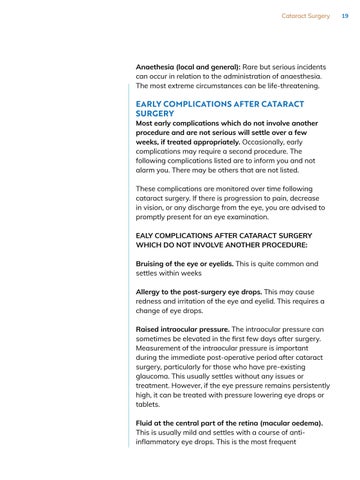Cataract Surgery
Anaethesia (local and general): Rare but serious incidents can occur in relation to the administration of anaesthesia. The most extreme circumstances can be life-threatening.
EARLY COMPLICATIONS AFTER CATARACT SURGERY
Most early complications which do not involve another procedure and are not serious will settle over a few weeks, if treated appropriately. Occasionally, early complications may require a second procedure. The following complications listed are to inform you and not alarm you. There may be others that are not listed. These complications are monitored over time following cataract surgery. If there is progression to pain, decrease in vision, or any discharge from the eye, you are advised to promptly present for an eye examination. EALY COMPLICATIONS AFTER CATARACT SURGERY WHICH DO NOT INVOLVE ANOTHER PROCEDURE: Bruising of the eye or eyelids. This is quite common and settles within weeks Allergy to the post-surgery eye drops. This may cause redness and irritation of the eye and eyelid. This requires a change of eye drops. Raised intraocular pressure. The intraocular pressure can sometimes be elevated in the first few days after surgery. Measurement of the intraocular pressure is important during the immediate post-operative period after cataract surgery, particularly for those who have pre-existing glaucoma. This usually settles without any issues or treatment. However, if the eye pressure remains persistently high, it can be treated with pressure lowering eye drops or tablets. Fluid at the central part of the retina (macular oedema). This is usually mild and settles with a course of antiinflammatory eye drops. This is the most frequent
19


